Improving Multilingual Team Communication with a Translation Studio
Don't let language barriers hold your team back

Managing a team involves more than tracking tasks. Clear and effective communication is essential, especially in multilingual workplaces. Whether onboarding new employees, delivering training, or sharing company updates, video content helps convey information clearly while keeping engagement high.
Despite this, only 64% of small companies use video as a means of training, compared to 88% of larger companies (Research.com). For bilingual and multilingual teams, translating video content into multiple languages adds another layer of complexity. Traditional translation methods can be costly, rely on professional services, or require employees to handle translations themselves, leading to inefficiencies and potential miscommunication.
Fortunately, there are cost-effective and time-saving solutions to improve communication across global teams. With the right tools, you can easily translate recorded video messages, training materials, and internal updates to reach a wider audience.
This guide provides the tools and strategies needed to enhance multilingual communication, ensuring alignment across international teams — no matter the company’s size or resources.
"Participation in global teams grew from 64% in 2010 to 89% in 2018 and continues to remain on the rise"
Table of Contents
- Onboarding and Internal Communication
- Training Material: Video
- Company Updates and Corporate Messages
- Collaboration
Onboarding and Internal Communication
Effective multilingual communication is essential for successful onboarding and internal communication in global businesses. However, 64% of multinational teams experience communication breakdowns due to language barriers, making it challenging for companies to ensure that new hires and employees understand key information.
Miscommunication in the workplace is a widespread issue, too — 81% of employees report that workplace miscommunication happens frequently or occasionally. This can lead to inefficiencies in onboarding, misunderstandings of company policies, and decreased engagement among multilingual teams.
Dubbing and Lip Sync
Using AI-powered video dubbing and translation tools, businesses can simplify onboarding and internal communication by:
- Dubbing onboarding videos for new employees
- Dubbing key internal communication video and audio to ensure all employees receive clear information
- Dubbing video-recorded meetings and HR communications
To create a dubbed video with lip sync, upload your video to the Kapwing Editor and find the Subtitles tool located in the left-hand sidebar. Then, select Dub video.
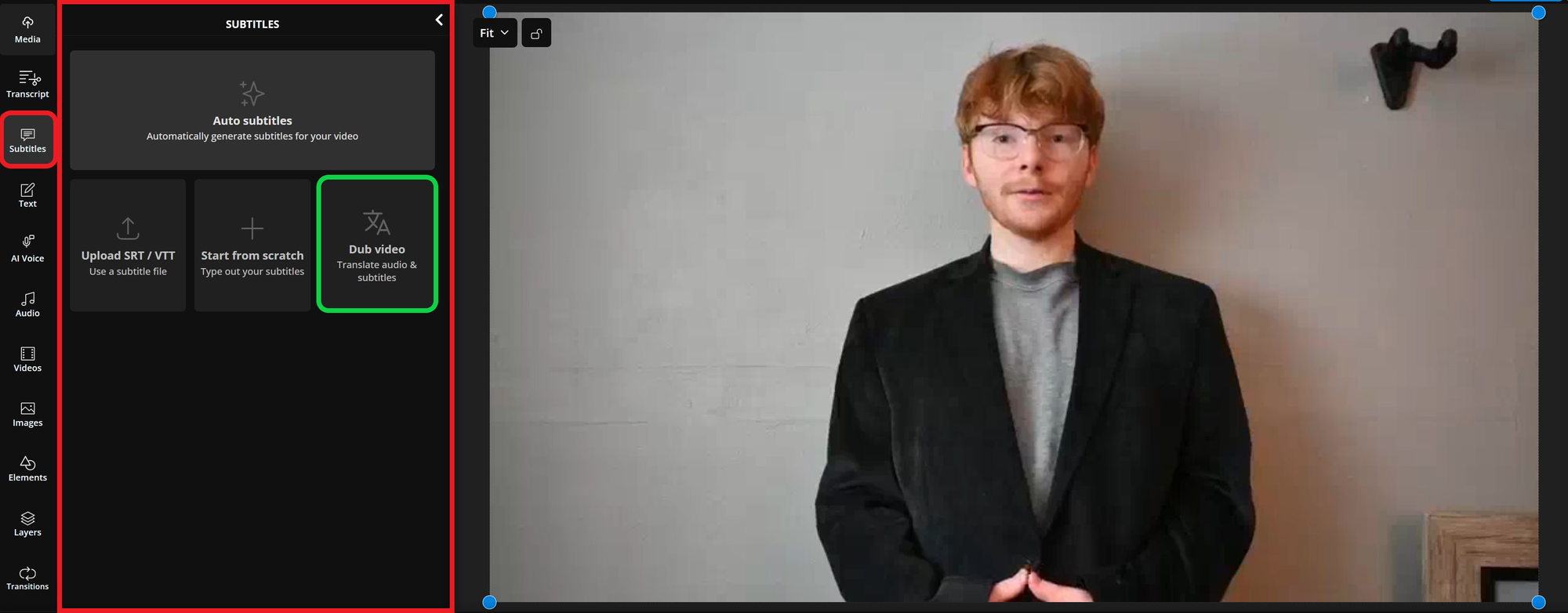
Configure your dubbed video by selecting the target language and preferred spoken voice
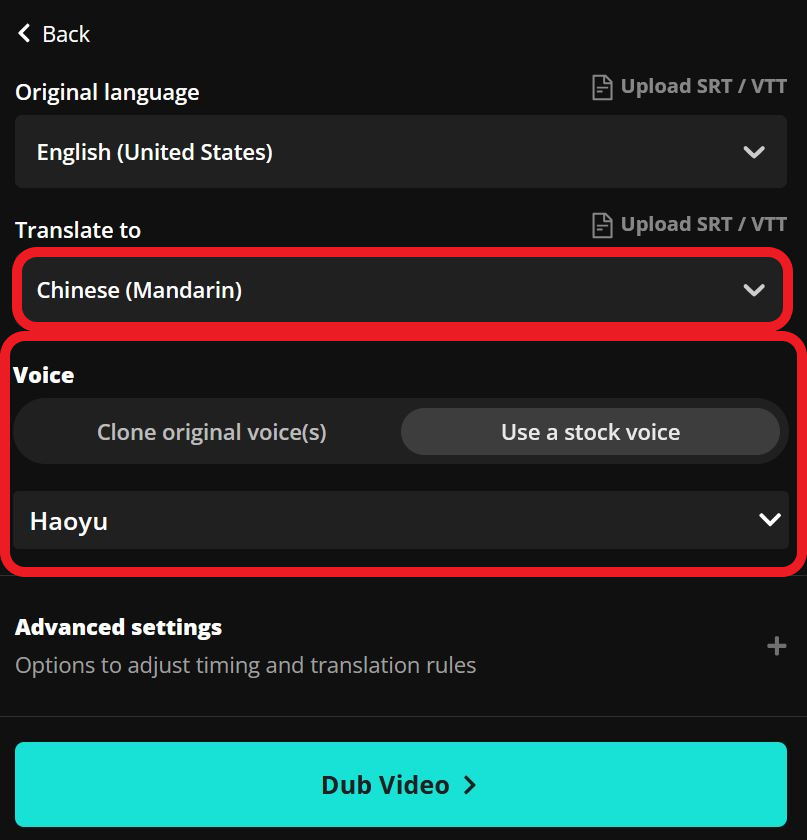
The final video will include both dubbed audio and subtitles in your chosen language.

In the dubbing process, there are two voice options to consider. The first is voice cloning, which translates videos while maintaining the original speaker’s voice. This is a great option for onboarding materials and internal videos, as it helps content feel more natural and authentic. By preserving a familiar voice, companies can build trust and keep employees more engaged.
The second option is stock voices, with Kapwing offering over 180 voices in 40+ languages to match your company’s tone and culture. This is a great choice for teams without confident voice-over speakers or for businesses looking to achieve a specific style or tone in their communications.
Key Benefits of Dubbing
- Quick, cost-effective, and easy to implement
- Ideal for announcements, company updates, and internal communications
- Great for translating content that doesn’t require precise lip-syncing
- Dub audio into up to 10 languages simultaneously, perfect for scaling content
- More engaging and immersive than subtitles, reducing the need for reading
Limitations of Dubbing
- Best suited for short-form communications rather than in-depth training materials
- Lacks professional polish due to the absence of lip-syncing
Pro Tip: Lip-syncing can take several minutes to process as it precisely matches lip movements with speech. This makes it less efficient for scaling large batches of translated content.
However, it adds a polished, professional touch to videos and is best suited for important training materials intended for long-term use, rather than quick multilingual communications.
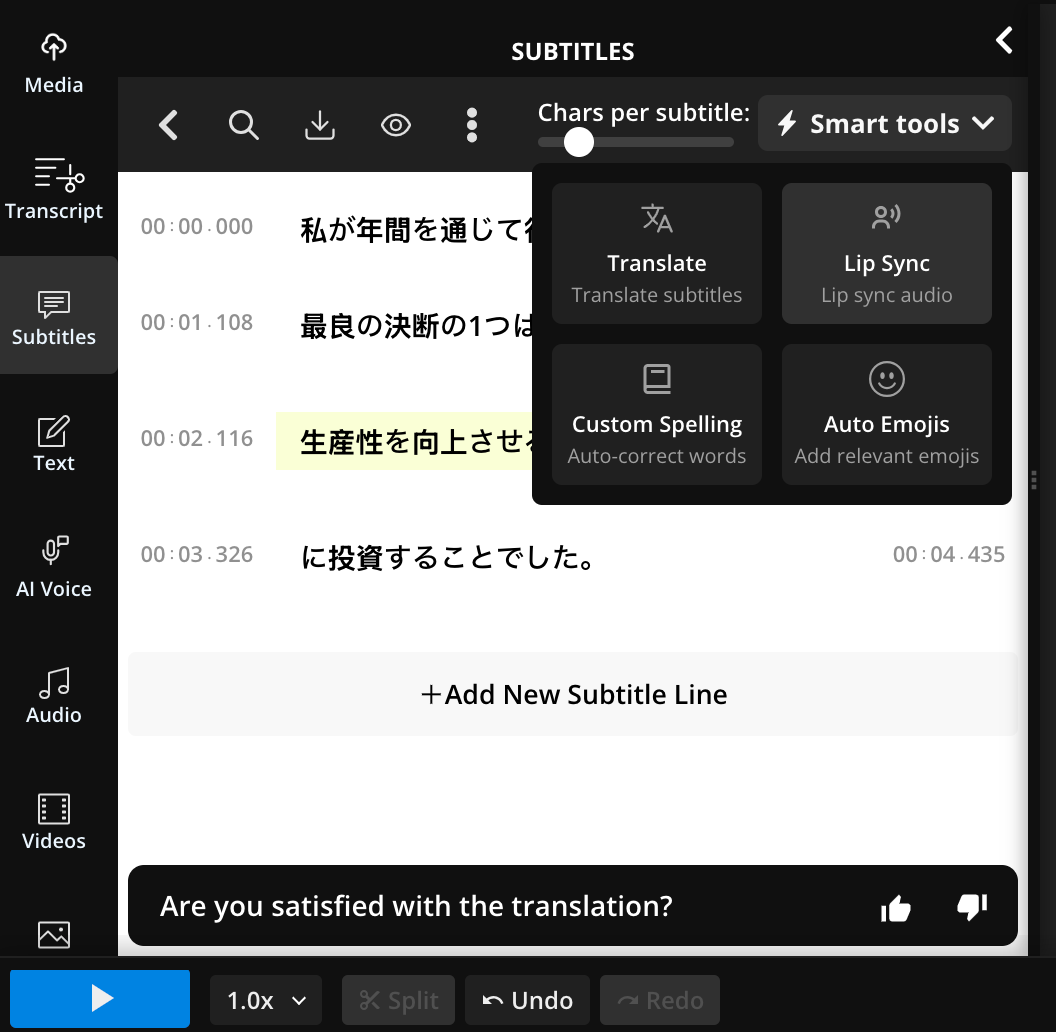
Image Translation
Visual content plays a crucial role in onboarding and internal communication, especially when sharing company graphics, infographics, or instructional images with a multilingual team. However, language barriers can reduce clarity and engagement, making it harder for employees to fully understand important information.
Translating images ensures that all employees, regardless of language, receive clear and consistent messaging, whether it’s for HR documents, safety guidelines, product visuals, or internal presentations. Instead of manually redesigning images for each language, businesses can use AI-powered image translation tools to automate the process and maintain design consistency.
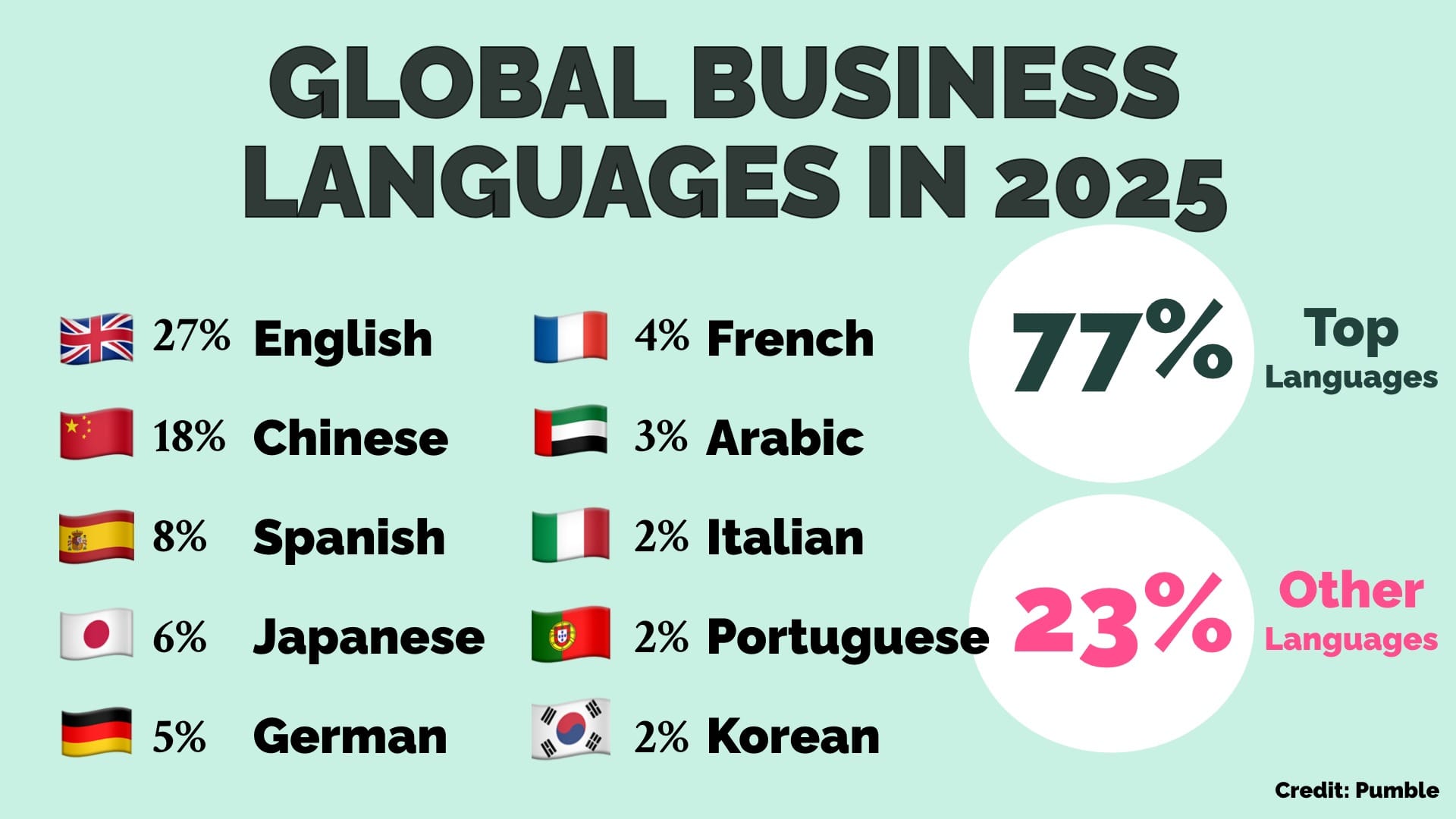
Kapwing’s Image Translation tool makes it easy to translate text within images while preserving the original design.
- Upload the image to the Kapwing Editor
- Open the AI Tools menu
- Select Translate Text from the right-hand sidebar
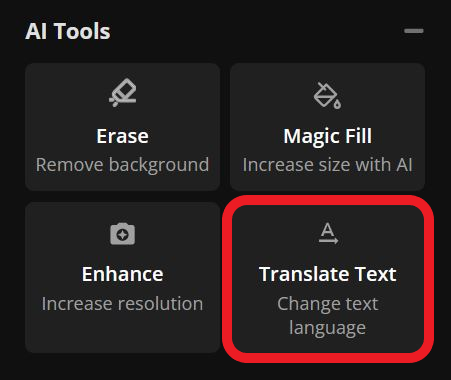
- Choose the target language for the translation
- Click "Translate Text", and Kapwing will automatically overlay the translated text onto the image
- Kapwing samples the background color from the original design to ensure a natural and professional look
By integrating image translation into onboarding and internal communications, businesses can improve accessibility, reduce misunderstandings, and create a more inclusive workplace for global teams.
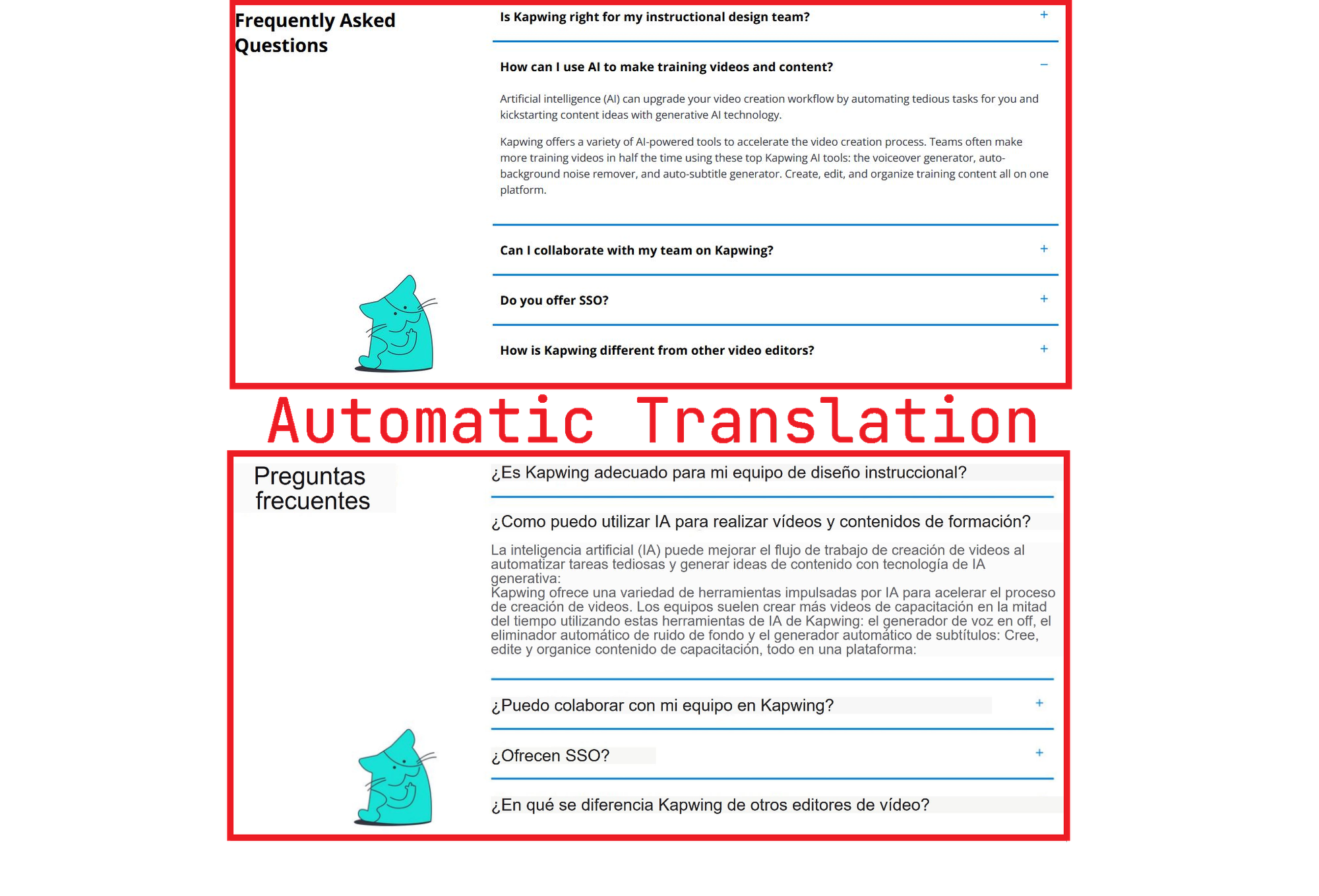
Key Benefits of Image Translation
- Quickly translates text within images while preserving the original design
- Ideal for HR documents, safety guidelines, and internal presentations
- Automates translation, eliminating the need for manual image redesign
Limitations of Image Translation
- Best suited for static content; interactive elements (e.g., videos) are suited to other tools
- Some complex layouts may require manual adjustments to ensure readability
- May not always capture context-dependent meanings, requiring review for accuracy
Training Material: Video
Clear and effective training materials are essential for skill development, employee retention, and operational efficiency. However, language barriers can limit understanding and engagement, especially in multilingual workplaces. Investing in bilingual training not only fosters inclusivity but also enhances employee morale, directly correlating to a 15% increase in productivity.
Without multilingual training materials, employees may struggle to grasp key concepts, leading to longer onboarding times, inconsistent performance, and knowledge gaps across teams.
Text to Speech and AI Personas
Text to Speech (TTS) technology converts written text into spoken audio using artificial intelligence, allowing businesses to generate natural-sounding voice overs without a human narrator. Unlike dubbing, which replaces spoken audio while preserving tone and inflection, TTS provides a fully synthesized voice, making it a faster and more scalable solution for training videos.
By incorporating AI-powered Text to Speech, businesses can easily create multilingual training videos without the need for manual translations or professional voice overs. This ensures that instructional materials are accessible, scalable, and engaging for diverse teams.
To generate a translated voice over, follow these steps:
- Open the AI Voice tool from the left-hand sidebar in the Kapwing Editor
- Enter your script by typing or pasting the training content into the input box
- Select your preferred language and voice to match your company’s training style
- Finalize the voice over by selecting Add Layer at the bottom of the AI Voice tab
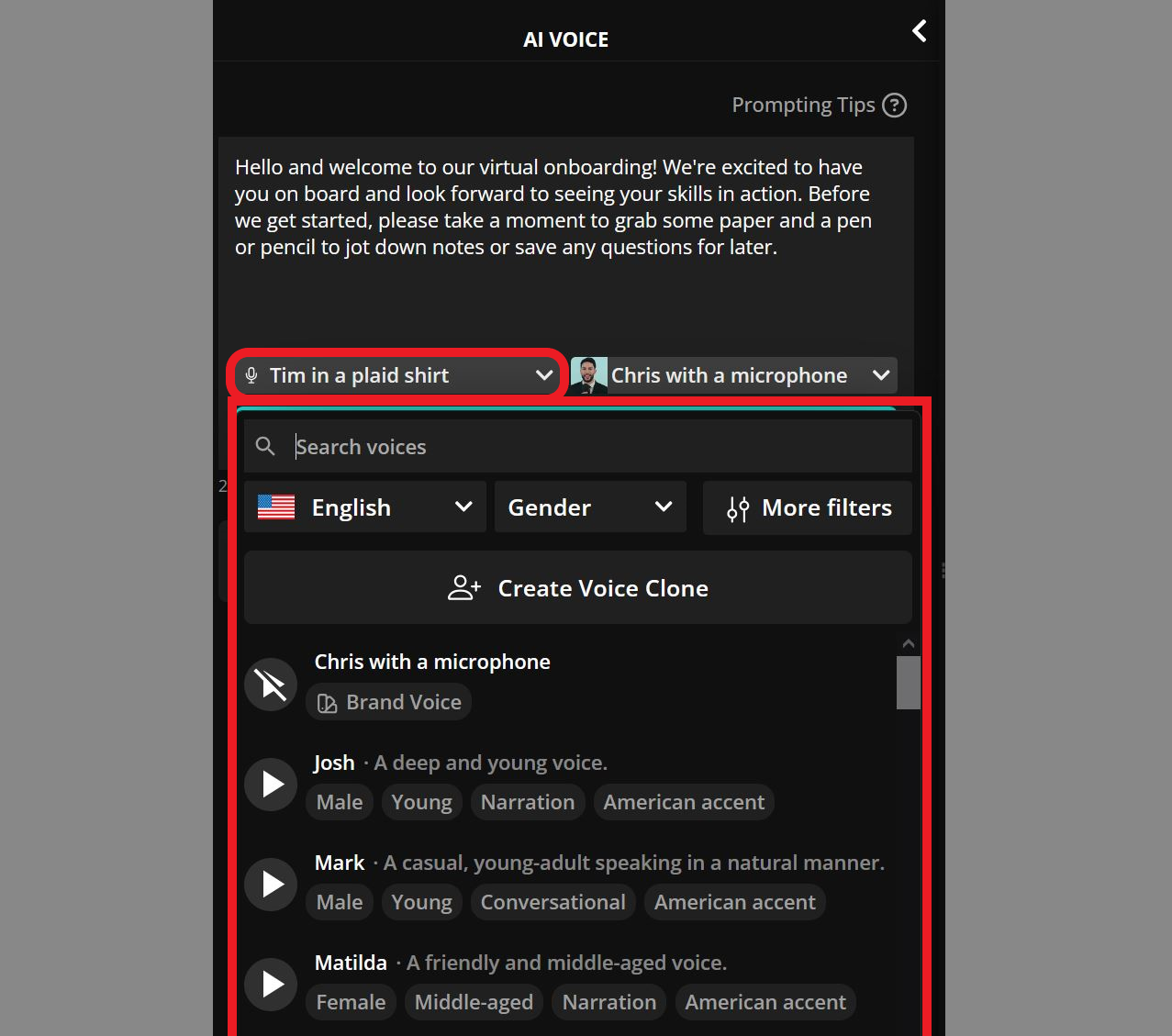
For your next tutorial or training video, consider using an AI Persona — a visual AI-generated presenter applied to Text to Speech voices. This feature allows you to pair a synthesized voice with either a stock AI presenter or custom footage you upload, making instructional content more engaging and easier to follow.
Videos are naturally more effective than written instructions, and having a visible speaker helps maintain attention and improve comprehension. By incorporating an AI Persona, you can create clear, professional training materials that resonate with multilingual teams and ensure consistency across all instructional content.
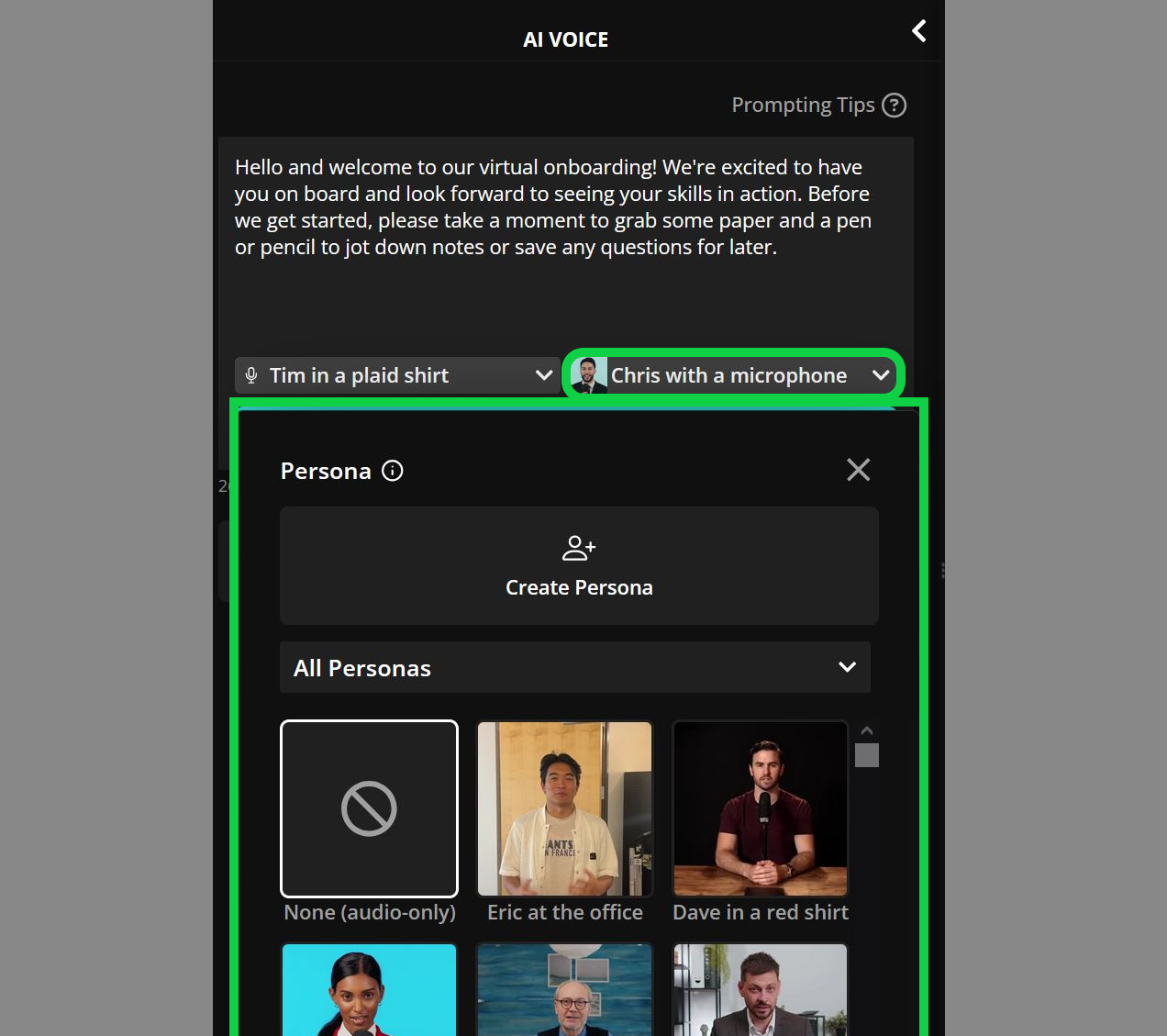
Key Strengths of Text to Speech
- Produces clear, natural-sounding voice overs quickly, converting text into speech without the need for manual recording
- Eliminates the need for staff-recorded voice overs or costly third-party services
- Allows businesses to create reusable AI Persona using staff, reducing the need for ongoing recordings
Limitations of Text to Speech
- AI-generated voices may lack the emotional depth of human speakers for more personalized content
Pro Tip: Kapwing also has a built-in screen recording tool for visual problem-solving with staff. The Screen Recorder allows you to record your screen, camera, or both simultaneously for clear, personalized feedback. Once recorded, you can edit the video directly in Kapwing by trimming clips, adding annotations, or applying automatic subtitles for accessibility.
Company Updates and Corporate Messages
Providing clear company updates does more than keep everyone informed. It enhances employee satisfaction and can reduce turnover rates by up to 50%. Ensuring these messages are both accessible and easy to understand is just as important as delivering them.
Just like social media content, internal communication videos need to be engaging to convey their message effectively. However, for professional videos, the stakes are even higher. Adding automatic subtitles can significantly improve clarity and engagement for all employees, including those in multilingual teams. AI-generated subtitles are fast, highly accurate, and have been shown to maintain video comprehension levels when compared to traditionally written captions.
Adding Automatic Subtitles
Generate automatic subtitles by selecting the Subtitles tool from the sidebar, then selecting Auto Subtitles.
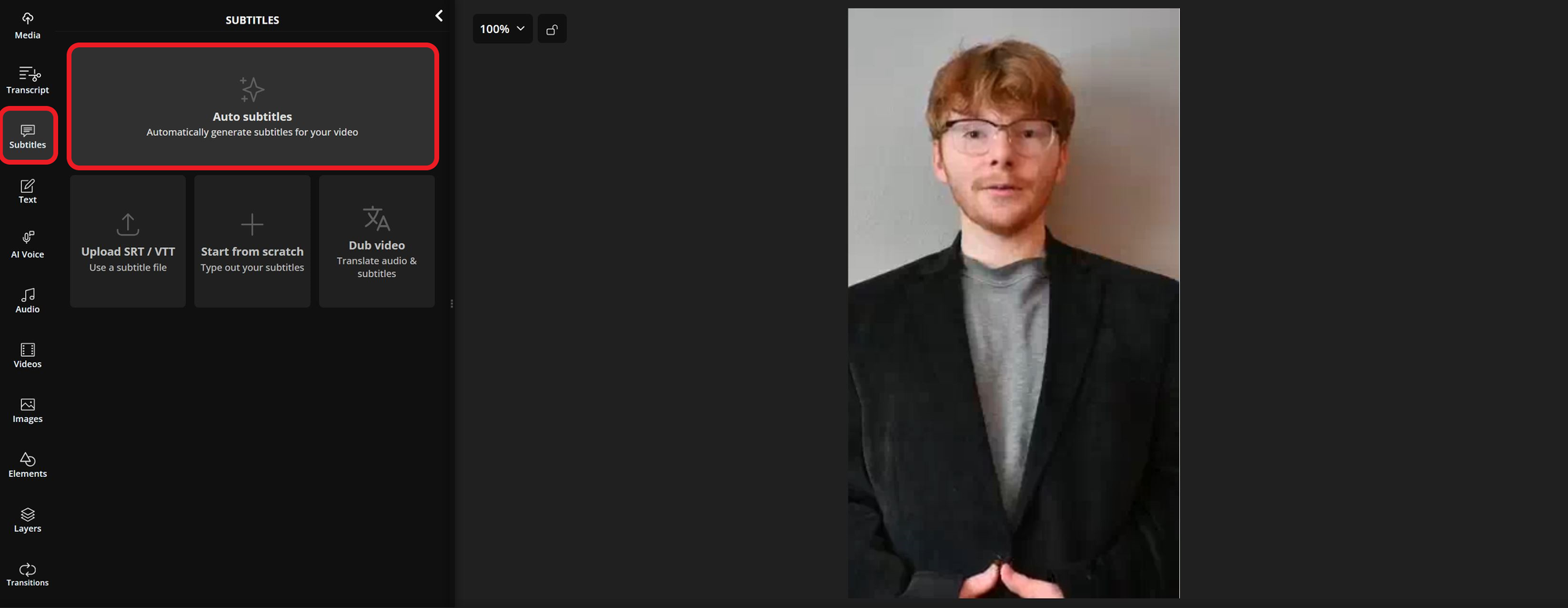
Finally, confirm the original language and language to translate to before selecting Auto Subtitle to start generating.

Once generated, your subtitles will be automatically arranged in the video timeline to match the timing of the spoken content.
To adjust subtitle timings or edit the script, use the Subtitles menu on the left-hand side. To customize the style — such as font, color, video effects, and more — use the tools on the right-hand side.
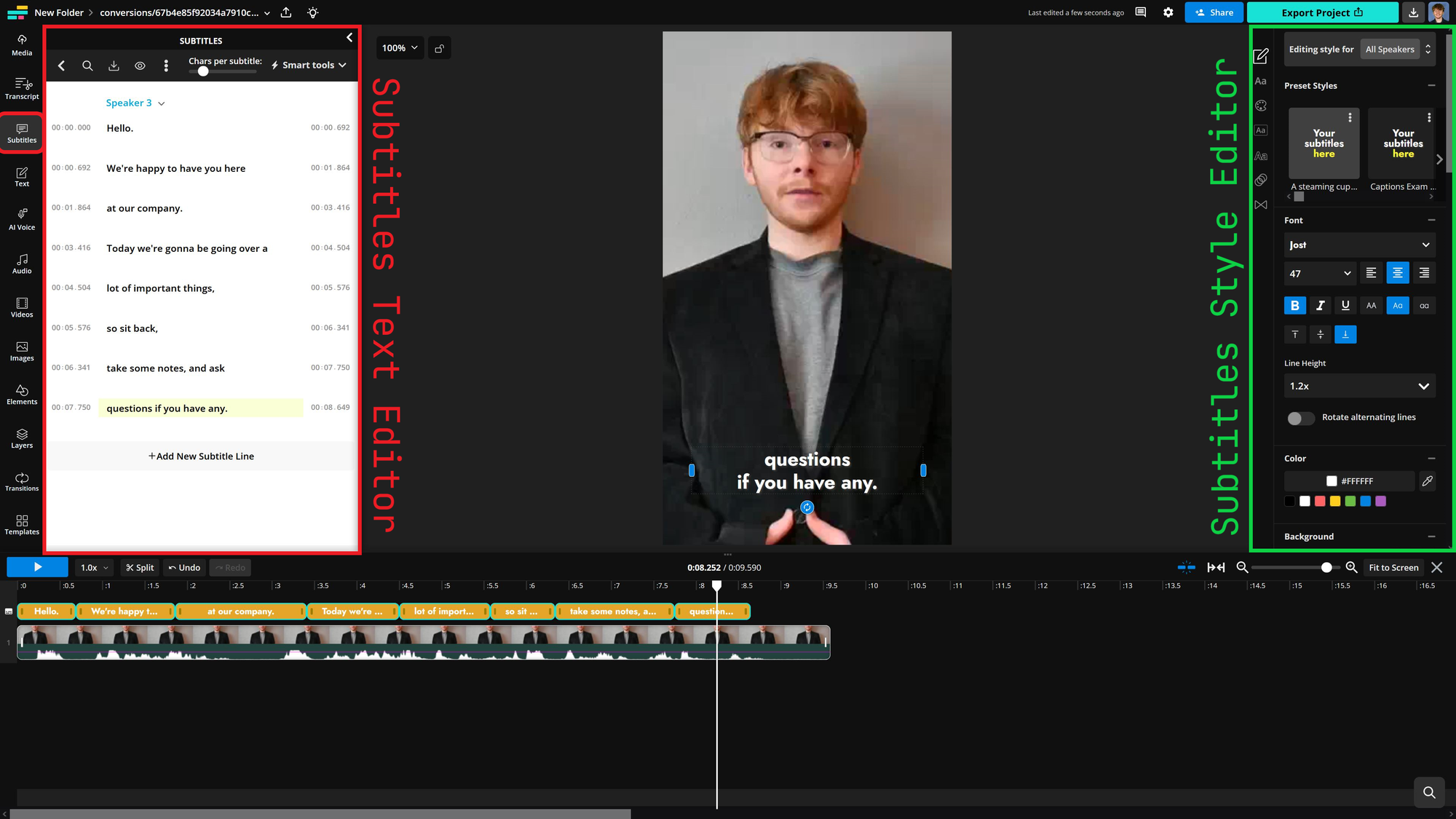
Key Strengths of Subtitles
- Quick and easy to add to any video, instantly making videos more accessible to multilingual teams
- Increases video engagement by as much as 80%
- Customizable to fit your brand's tone
Limitations of Subtitles
- May feel less personalized than dubbing and lip-syncing
- Requires viewers to read, which can be distracting and take up screen space, potentially obstructing visuals
- Less effective for content with complex terminology
Collaboration
Research shows that collaborative teams are 5 times more likely to achieve high performance and that companies with strong communication strategies are 3.5 times more likely to outperform their competitors. When it comes to creating company-wide materials, having a shared workspace for editing and translating content is essential for efficiency and accuracy.
Kapwing provides a practical solution for business teams working across languages. Its collaborative editing studio allows multiple team members to work on the same project simultaneously, eliminating version control issues and streamlining the localization process.
With unlimited cloud storage, training videos and instructional materials can be easily saved, updated, and translated into additional languages as needed, ensuring consistency in global communication.
Kapwing also offers brand management tools like a Brand Kit, where teams can store fonts, logos, and colors to maintain consistency across multilingual content. By providing your team with a centralized, accessible editing space, creators are empowered to collaborate efficiently, improving the clarity and accessibility of training materials across multilingual workforces.










